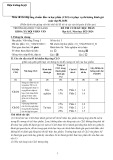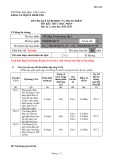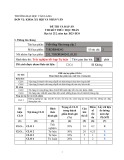
TNU Journal of Science and Technology 230(04): 452 - 459
http://jst.tnu.edu.vn 452 Email: jst@tnu.edu.vn
TEACHER CHANGE FOLLOWING PROFESSIONAL DEVELOPMENT
ENGAGEMENT: AN INVESTIGATION WITH EFL UNIVERSITY TEACHERS
Cao Hoang Yen, Phan Thi Tuyet Van
*
Can Tho University
ARTICLE INFO ABSTRACT
Received:
11/03/2025
As our world continues to evolve and education reforms are in
progress, teacher change has become a focal point of attention.
Teachers need to adapt themselves to meet new demands. This study
examines teachers' changes due to their engagement in profession
al
development. The study involved thirty-two English as a
foreign
language
teachers from two universities in the Mekong Delta, Vietnam.
Data on the changes teachers experienced after participating in
professional development were collected using a quest
ionnaire, and
descriptive statistical tests were used to analyze the data. The results
show that, over their careers, teachers took part in various
professional
development
activities, which helped them make positive changes in
their cognitive, behavioral,
and affective domains. These findings
highlight the potential of professional development
to foster teacher
change and improve the quality of education.
Revised:
26/04/2025
Published:
30/04/2025
KEYWORDS
Teacher change
Professional development
Engagement
University teachers
English as a foreign language
SỰ THAY ĐỔI CỦA GIẢNG VIÊN SAU KHI THAM GIA HOẠT ĐỘNG PHÁT
TRIỂN CHUYÊN MÔN: MỘT NGHIÊN CỨU VỚI GIẢNG VIÊN ĐẠI HỌC
DẠY TIẾNG ANH NHƯ MỘT NGOẠI NGỮ
Cao Hoàng Yến, Phan Thị Tuyết Vân*
Trường Đại học Cần Thơ
THÔNG TIN BÀI BÁO TÓM TẮT
Ngày nhậ
n bài:
11/03/2025
Trong bối cảnh thế giới không ngừng phát triển và cải cách giáo dụ
c
vẫn diễn ra không ngừng, sự thay đổi của giảng viên luôn là một vấn đề
được quan tâm sâu sắc. Giảng viên cần thay đổi bản thân để có thể
đáp
ứng các yêu cầu mới. Bài báo này phân tích thực trạng về sự thay đổ
i
của giảng viên sau khi tham gia các hoạt động phát triể
n chuyên môn.
Đối tượng nghiên cứu bao gồm ba mươi hai giảng viên giảng dạy tiế
ng
Anh tại hai trường đại học ở Đồng bằng sông Cửu Long, Việt Nam. Dữ
liệu về những thay đổi mà giảng viên đã trải qua sau quá trình thực hiệ
n
các hoạt động phát triển chuyên môn được thu thập thông qua bảng hỏ
i.
Các phương pháp thống kê mô tả được sử dụng để phân tích dữ liệ
u.
Kết quả nghiên cứu cho thấy trong quá trình công tác, giảng viên đ
ã
tham gia nhiều hoạt động phát triển chuyên môn khác nhau và điề
u đó
đã giúp họ có được những thay đổi tích cực trong khía cạnh nhận thứ
c,
hành vi cũng như tình cảm. Kết quả này khẳng định tiềm năng thúc đẩ
y
sự thay đổi của giảng viên thông qua các hoạt động phát triể
n chuyên
môn đ
ể
nâng cao ch
ấ
t lư
ợ
ng giáo d
ụ
c.
Ngày hoàn thiệ
n:
26/04/2025
Ngày đăng:
30/04/2025
TỪ KHÓA
Sự thay đổi của giảng viên
Phát triển chuyên môn
Sự tham gia
Giảng viên
Tiếng Anh như một ngoại ngữ
DOI: https://doi.org/10.34238/tnu-jst.12263
* Corresponding author. Email: pttuyetvan@ctu.edu.vn

TNU Journal of Science and Technology 230(04): 452 - 459
http://jst.tnu.edu.vn 453 Email: jst@tnu.edu.vn
1. Introduction
Human resources always play a crucial role in development. In many countries, including
Vietnam, education is considered a national policy because the product of education is people.
Teacher education and training are always of great concern in building a qualified teaching staff
that meets innovation requirements. Pre-service teachers have the necessary knowledge and skills to
become effective teachers. Afterward, in-service teachers are continuously trained to improve their
expertise. Participation in professional development (PD) has become a task teachers must perform
during their career journey to face the challenges of constant changes in teaching materials,
techniques, and methods [1] and the transience of professional knowledge [2]. This shows the
importance of PD engagement in the education sector. In the context of strong educational reform,
teachers' participation in PD has received even more attention as it is closely connected to teacher
change, a key factor in educational reform and social development. In Vietnam, university teachers
are required to engage in PD to effectively perform their roles, which go beyond general English
teaching to include curriculum design, academic advising, or research supervision. PD activities of
university teachers are self-initiated or institution-led activities aiming to improve individual and
institutional development [3]. They consist of formal PD (e.g., workshops, conferences, meetings or
courses) and job-embedded PD (e.g., lesson observation, coaching or mentoring, study groups,
reflective practices, action research, or sharing of best practices) [4].
Several recent studies have investigated teachers' engagement in PD and teacher change.
Mahmoudi and Özkan [5] compared the perceptions of novice and experienced Turkish language
teachers regarding PD. They found that teachers' choices of PD were completely different. Most
experienced teachers indicated that they frequently participated in mentoring or peer coaching,
reading professional literature, conferences, and seminars. Meanwhile, less experienced teachers
reported their regular participation in courses/workshops, professional communities, and reading
professional literature. However, PD helped teachers explore new roles, foster new instructional
techniques and teaching methodologies, enhance their practice, and develop themselves
professionally and individually.
In Indonesia, EFL teachers' experiences of PD were explored by Hartono [6]. Interviews with
six teachers from four universities showed that PD was perceived as an activity that could help
them become competent teachers. Thanks to a variety of PD activities (e.g., seminars,
conferences, workshops, writing scholarly articles, conducting research, having publications,
joining professional organizations, reading and finding sources, developing teaching methods,
becoming a coach, examiner, or a teacher trainer), teachers could gain more knowledge that
supported their professional growth. Hartono also found that EFL teachers' participation in
ongoing PD became part of individual efforts rather than institutional requirements, as they had
to determine how to be involved in PD.
In the Republic of Benin, Agbayahoun [7] surveyed 157 secondary EFL teachers to explore
their views on PD. The results showed that teachers frequently engaged in one-shot courses that
followed top-down models, but these activities could not help teachers enhance their skills in
reflection and action on practice. Additionally, teachers were not accustomed to other PD
activities such as action research, reading research findings in the field, peer observation,
mentoring, or networking. The participants also reflected that although top-down PD exposed
them to informative input, these opportunities did not significantly influence their teaching and
student outcomes.
In Iran, Nazari and Xodabande [8] investigated how five EFL teachers transformed their beliefs
and practices regarding mobile phone usage in language teaching after a ten-week PD program
focused on mobile phone integration. The findings revealed shifts in teachers' beliefs about the
educational potential of mobile phones. Moreover, the integration of mobile phones into language
classrooms increased, especially among teachers who had not used them frequently.

TNU Journal of Science and Technology 230(04): 452 - 459
http://jst.tnu.edu.vn 454 Email: jst@tnu.edu.vn
In Vietnam, Ha and Murray [9] conducted a qualitative study to explore how ten Vietnamese
EFL high school teachers' beliefs regarding oral corrective feedback (CF) changed after a PD
program. The program included a workshop and follow-up experiential and reflective activities
such as peer observation or self-video-recorded lesson reflections. The results indicate that the
program raised teachers' consciousness of giving CF and choosing appropriate feedback types.
However, most teachers retained their beliefs about errors that need correction and potential
helpful sources of corrective feedback.
In another study, Nguyen et al. [10] explored how eighty EFL high school teachers
participated in PD and their perceptions of the impacts of PD. Data from the questionnaire and
semi-structured interviews revealed that teachers participated in institution-internal or in-house
PD activities on an occasional basis. Also, PD has positively reinforced teachers' language
proficiency, teaching practice, and planning practical lessons to meet students' learning needs.
Regarding the university setting, Nguyen and Newton [11] examined the perceptions of six
EFL teachers about the effects of a professional program in pronunciation teaching on their
knowledge and pronunciation teaching skills. The findings showed that the workshop positively
impacted teachers' pedagogical knowledge and pronunciation teaching practices. Teachers
implemented what they learned from the program into their pronunciation teaching practices. The
results indicated that workshops can effectively promote teacher change.
Research on teachers' engagement in PD and its contribution to teacher change has been
conducted in various contexts using diverse methodologies. The results of the studies highlight
the positive impacts of PD engagement by demonstrating its role in transforming teachers'
knowledge or beliefs regarding their profession and their teaching and learning practices. In
Vietnam, several studies have examined teacher change following PD participation. However,
these studies primarily focus on secondary or high schools. Research on teacher change in
university settings remains scarce. Moreover, most existing studies are qualitative or small in
scale, limiting the generalizability of their findings. This gap highlights the necessity for
quantitative research involving larger samples to better understand teacher change following PD
within Vietnamese university contexts, which may have distinctive features compared with
school contexts. Accordingly, the present study examined how EFL teachers at two universities
in the Mekong Delta engage in PD and how they have changed due to PD engagement.
The study aimed to answer two research questions:
- How have Vietnamese EFL university teachers engaged in PD?
- What changes have teachers undergone as a result of PD engagement?
2. Methodology
2.1. Research design and research instrument
The present research is a descriptive study exploring teachers' PD engagement and subsequent
changes. The researchers designed a questionnaire based on the existing literature on teacher
change and PD to capture data. The questionnaire was reviewed by two experts in the field and
piloted before being administered to ensure its reliability and validity.
The questionnaire comprises three main sections investigating the participants' demographic
background, their engagement in PD, and the changes they have undergone after PD engagement. The
first section of the questionnaire contains six closed-ended questions for which the participants tick
the most appropriate answers. In part two, nine five-point Likert scale questions were used to collect
data on participants' experiences. Section three comprises twenty-eight five-point Likert scale
questions investigating changes teachers have undergone due to PD engagement.
2.2. Research sites and participants
The study was conducted at two universities in the Mekong Delta. These universities were

TNU Journal of Science and Technology 230(04): 452 - 459
http://jst.tnu.edu.vn 455 Email: jst@tnu.edu.vn
chosen based on convenience. The researchers chose these universities due to their established
relationships with them, ensuring easier data collection. The participants included thirty-two EFL
teachers selected based on three criteria: voluntary participation in the study, being full-time
teachers, and having at least one year of experience as a full-time teacher at the university.
2.3. Data collection and analysis
The data was collected through a questionnaire. The researchers contacted the target
participants, arranged a meeting to explain the purpose of the study, and invited them to participate.
The participants were encouraged to raise questions if they needed more detailed information.
Those who agreed to participate were allowed to respond electronically via a Google Form or
paper-based form, depending on their preferred reading mode, to ensure the participants' comfort.
The data were analyzed using SPSS 26. The Reliability test was run to measure the reliability
of the questionnaire. The test result yielded a high Cronbach's Alpha of 0.959, indicating strong
questionnaire reliability. Descriptive statistical tests such as Descriptives and Frequencies were
also conducted to measure the items' mean scores, frequencies, and standard deviation. The mean
scores were interpreted using the framework of scale interpretation provided by [10] as follows:
Strongly disagree in the point range of 1.00- 1.80, Disagree 1.81 - 2.60, Neutral 2.61 – 3.40,
Agree 3.41 - 4.20, and Strongly agree 4.21 - 5.00.
3. Results and discussion
3.1. Findings on teachers' engagement in PD
Descriptive statistical tests were run to measure the degree to which teachers participated in
PD. The overall mean score of the nine items related to teachers' engagement in PD was 3.92 (SD
= 0.443), indicating that the extent of teachers' engagement in PD is high. Table 1 presents the
results of the tests for the nine items in the cluster.
Table 1. Descriptive statistics on teachers' engagement in PD
Items Mean SD
Strongly
disagree and
disagree (%)
Neutral
(%)
Strongly
agree and
agree (%)
1. I have engaged in various PD activities.
4.16
0
.628
0
12.5
87.5
2. I have engaged in PD regularly as a habit.
3.78
0
.751
6.3
21.9
71.8
3. I have engaged in PD required by my
organization.
3.91 0.893 9.4 15.6 75
4. I have engaged in PD, which helps address
issues in my work.
4.00 1.016 9.4 12.5 78.1
5. I have engaged in PD that I am invited to.
3.81
0
.965
9.4
18.8
71.9
6. I have engaged in PD that aligns with my
personal interests or available time.
3.56 1.162 21.9 21.9 56.3
7. I have engaged in formal PD.
3.72
0
.683
3.1
31.3
65.7
8. I have engaged in informal and collaborative PD.
3.97
0
.695
0
25.0
75.0
9. I have engaged in self
-
directed PD.
4.34
0
.653
0
9.4
90.6
The mean scores of all nine items exceeded 3.4, indicating teachers' overall agreement with
the ideas. The strongest agreement was observed for item 9 (M = 4.34, SD = 0.653), with over
90% of teachers reporting participation in self-directed PD. Similarly, item 1 got a high mean
score of 4.16 (SD = 0.628) and agreement from nearly 90% of teachers, indicating that teachers
engaged in various PD activities. Regarding the frequency of PD engagement, around 71% of
teachers agreed that participating in PD is their routine (M = 3.78, SD = 0.751). The lowest mean
score was recorded for the item about engaging in PD activities appropriate to personal interest
and available time (M = 3.56, SD = 1.162), showing that these two personal factors might not
influence teachers' decisions to participate in PD. Meanwhile, nearly 80% of teachers reported

TNU Journal of Science and Technology 230(04): 452 - 459
http://jst.tnu.edu.vn 456 Email: jst@tnu.edu.vn
participating in PD activities that help them solve their teaching problems (M = 4.00, SD =
1.016). About three-quarters of teachers participated in mandatory PD activities (M = 3.91, SD =
0.893) or informal and collaborative (M = 3.97, SD = 0.695). Moreover, about two-thirds of
teachers also engaged in PD opportunities that are formally organized (M = 3.72, SD = 0.683)
and the ones that teachers are invited to (M = 3.81, SD = 0.965).
3.2. Findings on teacher change following PD engagement
Descriptive statistical tests were conducted to measure the changes in teachers' cognitive,
behavioral, and affective domains after their engagement in PD. The results showed that PD
engagement has resulted in teacher change in all three domains. The overall mean score for
teacher change was 4.30 (SD = 0.501), indicating a strong agreement among teachers that their
participation in PD facilitated their transformation. The mean scores for the three domains of
change (e.g., cognitive, behavioral, and affective) were 4.37 (SD = 0.497), 4.26 (SD = 0.540),
and 4.25 (SD = 0.566), respectively, suggesting that teachers perceived positive changes across
all areas as a result of their PD engagement.
3.2.1. Teacher change in the cognitive domain
The results regarding teacher change in the cognitive domain are presented in Table 2.
Table 2. Descriptive statistics on teacher change in the cognitive domain
Items Mean
SD
Strongly
disagree and
disagree (%)
Neutral
(%)
Strongly agree
and agree (%)
PD engagement has helped me…………
1. have a clear understanding of the content of
the subject I am teaching.
4.56 0.564
0 3.1 96.9
2. have a clear understanding of how to carry out
the teaching process.
4.41 0.615
0 6.3 93.7
3. have a clear
understanding of how to use
teaching materials to support teaching.
4.37 0.609
0 6.3 93.7
4. have a clear understanding of how to
implement differentiated teaching.
4.19 0.780
0 21.9 78.1
5. be aware of the influences of learners'
variables.
4.31 0.592
0 6.3 93.7
6. recognize the changes occurring in the field of
English teaching.
4.06 0.759
6.3 6.3 87.4
7. be aware of the role of the teacher in the
teaching process and PD.
4.47 0.507
0 0 100
8. recognize the necessity of engaging in PD
activities to become an effective teacher.
4.50 0.508
0 0 100
9. recognize the PD path that suits my personal
needs.
4.34 0.653
0 9.4 90.6
10. be aware of the importance of teacher change
in
enhancing the quality of education.
4.44 0.504
0 0 100
The mean scores of the items ranged from 4.06 to 4.56, with the percentage of teachers who
agreed or strongly agreed ranging from 78.1 percent to 100 percent. This reflects that teachers
valued the positive influence of PD engagement on changes in their cognitive domain. Teachers
agreed that PD engagement resulted in their identification of changes in English language teaching
(M = 4.06, SD = 0.759) and understanding how to implement differentiated instruction (M = 4.19,
SD = 0.780). Remarkably, they strongly agreed on the contribution of PD in enhancing their
knowledge about the subjects they are teaching (M = 4.56, SD = 0.564), how to carry out the
teaching process (M = 4.41, SD = 0.615), how to use supplementary teaching materials and












![Tài liệu Từ vựng tiếng Anh Trung cấp [mới nhất]](https://cdn.tailieu.vn/images/document/thumbnail/2025/20250913/nguyentuan250421@gmail.com/135x160/99491757910839.jpg)
![Tài liệu Từ vựng Tiếng Anh theo chủ đề [mới nhất]](https://cdn.tailieu.vn/images/document/thumbnail/2025/20250913/namdhuet@gmail.com/135x160/83251757753810.jpg)



![Tài liệu Từ vựng tiếng Anh cho bé [chuẩn nhất/mới nhất]](https://cdn.tailieu.vn/images/document/thumbnail/2025/20250731/huadaithesang2509@gmail.com/135x160/18631754013896.jpg)








